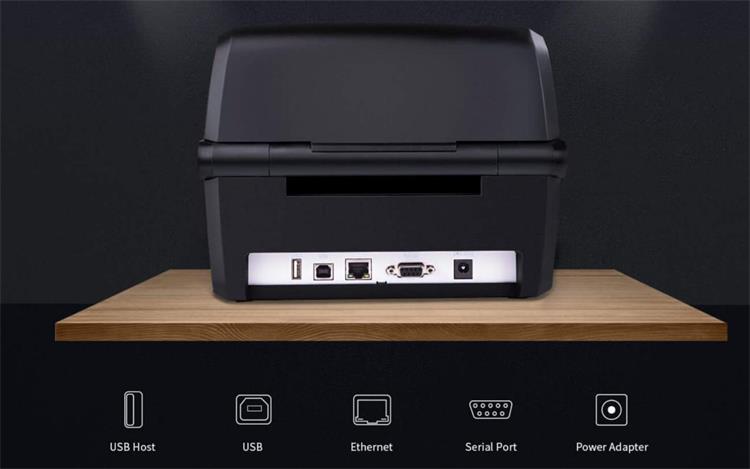When shopping for mobile or desktop barcode printers, the type of interface is an essential factor to consider. The interface refers to the methods or protocols used for connecting a printer to a computer or network. Different interfaces not only affect the functionality of the printer but also determine its compatibility with other devices. This guide, in association with iDPRT barcode printers, aims to provide an in-depth look at the characteristics and primary applications of various common interfaces.

Types of Interfaces in Barcode Printers
In barcode printers, interfaces can be broadly categorized into two main types: wired and wireless. Wired interfaces are typically used for connecting to computers or other stationary devices, while wireless interfaces are more frequently utilized for mobile devices or remote operations.
Wired Interfaces
1. Serial Port
The serial port, commonly referred to as the COM port, is an interface type that operates on serial communication protocols. Unlike parallel interfaces, serial interfaces transmit data sequentially, one bit at a time. A significant feature of this interface is its relatively straightforward communication line, requiring only a pair of transmission lines to facilitate bidirectional communication. However, its limitations in transmission distance and speed render it unsuitable for long-range communication.
In desktop computers, there are generally two types of serial ports: COM 1 and COM 2. COM 1 typically employs a 9-pin D-shaped connector, also known as the RS-232 interface. On the other hand, COM 2 in earlier versions used a DB25 pin connector, referred to as the RS-422 interface. However, due to technological advancements and evolving needs, the RS-422 interface is now rarely used.
Pros:
● High prevalence: Given its long history, the serial port is widely used in various devices, especially in barcode printers for stable and reliable connections with computers, POS systems, and data collection devices.
● Cost-effectiveness: Due to its simple communication line, the cost of the serial port is relatively low.
Cons:
● Poor networking capabilities: Serial ports are not suitable for complex network environments.
● Electromagnetic sensitivity: Serial ports are susceptible to electromagnetic interference, which can lead to unstable communication or port damage.
● Limited speed and distance: Due to its inherent limitations, it is generally more suitable for low-speed and small data volume communication scenarios.
2. USB Interface
The USB (Universal Serial Bus) interface is a common type, often used for data transfer between the barcode printer and computers or other data processing devices. Unlike serial ports, USB interfaces use parallel transmission, offering higher data transfer speeds. This interface supports plug-and-play, making device connections simpler and more convenient.
In barcode printers, various types of USB interfaces are available, such as USB-A, USB-B, and USB-C. Among these, USB-A and USB-B are the most frequently utilized for establishing connections with computers or other primary host devices.
Pros:
● High-speed data transfer: USB interfaces can offer speeds up to 10Gbps, suitable for high-speed data transfer.
● Plug-and-play convenience: The interface supports immediate device recognition and operation upon connection.
Cons:
● Signal attenuation: Not suitable for long-distance transmission.
● Higher cost: Compared to serial ports, USB interfaces are generally more expensive.
3. USB Host
The USB HOST interface is a specialized type of USB interface, commonly used for connecting external storage devices such as USB drives or portable hard drives. This interface allows barcode printers to directly read or write data from or to external storage devices, eliminating the need for a computer as an intermediary. This feature grants barcode printers a high degree of flexibility and operational convenience.

Professional barcode printers from iDPRT, such as the iT4P and all industrial printers, come equipped with USB HOST interfaces. For instance, operators on the production line can directly insert a USB drive to print, bypassing the need for a network or computer and eliminating the requirement for additional driver installations, thereby significantly simplifying the workflow.
Pros:
● Operational Flexibility: The USB HOST interface allows for direct data transfer from external storage devices, enhancing the printer’s versatility.
● Simplified Workflow: Eliminates the need for a computer or network, as well as additional driver installations, making operations more straightforward.
Cons:
● Compatibility Issues: The interface may not be compatible with all external storage devices, which is a factor to consider.
● Higher Cost: Due to its added functionalities, the USB HOST interface is generally more expensive compared to standard USB interfaces.
4. Ethernet Port
The Ethernet port is a standard interface specifically designed for Local Area Networks (LAN). Unlike USB and serial ports, the Ethernet port is primarily used for data communication between networks, allowing multiple devices to exchange data within the same network environment.
In the context of barcode printers, Ethernet ports are mainly used for remote printing and device management, especially in large-scale production or multi-device network settings, where their application is extensive.
Pros:
● High-Speed Data Transfer: Ethernet ports can support data transfer speeds up to 1Gbps or higher, meeting the demands of large-scale production and data processing.
● Network Scalability: The Ethernet port offers excellent network expandability, allowing users to easily extend the scale of devices and networks by connecting to network switches or routers.
● Remote Device Management: Supports remote management of devices, thereby increasing work efficiency.
Cons:
● Limited Effective Distance: The typical Ethernet connection has a limited effective range, which may require additional network hardware for signal amplification.
● Higher Cost: Compared to serial and USB interfaces, Ethernet ports are generally more expensive due to the need for additional network hardware and more complex configurations.
In addition to the aforementioned common interfaces, wired connections also include parallel ports and PS/2 interfaces. Parallel ports were primarily used for connecting early-generation printers but have now largely become obsolete. PS/2 interfaces, on the other hand, are mainly used for connecting keyboards and mice, although their usage has also been gradually declining.
Wireless Interfaces
1. Bluetooth Connection
Bluetooth connections in barcode printers are mainly used for short-range wireless data transfer, often paired with desktop or portable barcode printers.
Pros:
● Low power consumption: Bluetooth technology is known for its low energy requirements, making it highly suitable for retail, warehousing, and logistics scenarios that require quick, flexible operations.
● Quick connection: Easily connects with mobile devices like smartphones and tablets.
Cons:
● Limited transmission distance and data rate: Generally not suitable for large-scale or complex network environments.
2. Wi-Fi Connection
Wi-Fi connections in barcode printers offer higher data transfer speeds and a greater effective range, often used in industrial or high-end desktop barcode printers.
Pros:
● High-speed data transfer: Supports high-speed data transfer between devices.
● Multi-device support: Allows multiple devices to be online simultaneously, greatly enhancing work efficiency.
Cons:
● Complex network configurations: Generally requires more complex network configurations and higher costs, including the purchase and maintenance of related network devices.
In summary, both Bluetooth and Wi-Fi have their advantages and limitations. The choice between the two depends on the specific application scenario and requirements. Bluetooth is more suitable for simple, quick operations, while Wi-Fi is more apt for scenarios requiring high-speed data transfer and remote management.
We hope that this detailed guide helps you choose the most suitable barcode printer interface for your business needs. iDPRT not only offers a variety of interface options but also provides additional modules for Bluetooth and Wi-Fi to meet the demands of different application scenarios.

It’s worth noting that as technology continues to advance, the types and functionalities of barcode printer interfaces will become increasingly diverse. Therefore, keeping an eye on the latest interface technologies and application trends will help you better understand the future developments and market dynamics of barcode printers.







